Every month around 590 people search in google by typing down, ‘pin nailer vs brad nailer’.
This tells us how many people are confused about this topic.
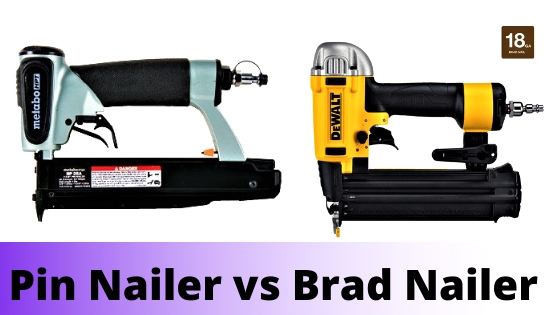
Here’s the thing-
If you’re into carpentry work, then you must’ve come across this feud. So, which one is the best?
Well, some say pin nailers all the way while some prefer brad nailers. But we’ll not give you some plain answer. Here, we will present a well-structured and detailed explanation. And after this explanation, you’ll be able to decide which one’s the best.
So, let’s not waste any more time and jump right into the details-
What is a Pin Nailer?
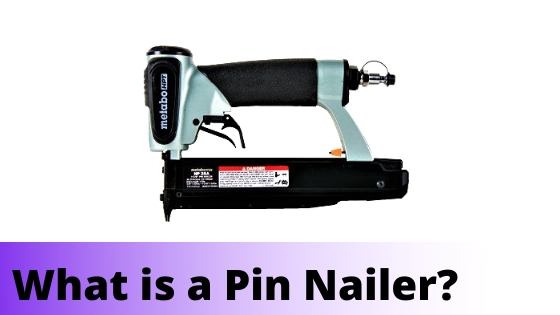
Pin nailer is basically, the smallest finish nailer. And this small nailer uses super thin 23- gauge pins. A traditional pin nailer stands between 2″- 0.75″ in size.
In other words, this is a headless pin nailer that makes slightly visible holes to send out pins. Even though this is a small-sized nailer, it’s pretty strong. It can pierce through any hardwood super easily.
The pins used in the pin nailer doesn’t have arches. So, it uses two things to hold on to objects-
- Tensile strength and
- Cohesive forces
However, manufacturers use pin nailers for holding light objects and at best heavy clothes. And most of the time, 23-gauge pin nailers are used alongside glues to secure something at a place. For example, holding woods in place until the wood glue dries up.
Although these pins come with weak holding power, most carpenters like these because of one reason. That is, pin nailer holes don’t create big holes. So, you don’t need to fill up those holes using putty afterward.
So, the bottom line here is, pin nailers are just little nailers. These throw headless super thin pins to pierce through thin wood. However, these pins aren’t appropriate for some structural work.
What is Brad Nailer?
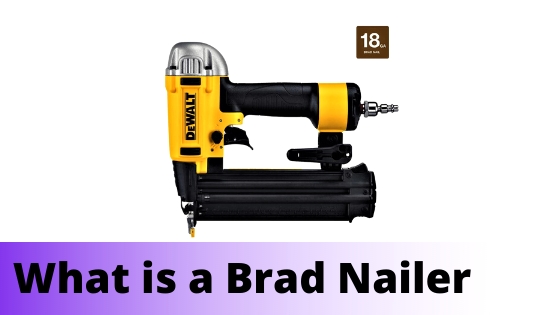
Brad nailers are the next level pin nailers. The main difference between a brad nailer and pin nailers are the brad nails. So, what is this brad nail?
Well, brad nails are the smallest nails out there. But keep in mind that these are nails. So, these nails are obviously bigger than pins. Moreover, these nails have a small head.
Brad nailer throws these brad nails into the target object. As a result, the target object gets pierced by the nail. Allowing the object to stay fixed.
These nailers are great for doing the finishing touches of a project. And if you want to finish that project without involving any glue or putty then 18-gauge brad nailers are just perfect. However, brad nailers are incredibly good at doing some specific works. These are –
- Attaching trim to your project
- Attaching some molding to your cabinets.
But there’s a catch-
Even though brad nailers use nails, these aren’t just right for heavy-duty jobs. Brad nailers usually use 18-gauge nails. These nails aren’t just big enough to hold strong forces or heavy objects.
Moreover, the brad nailer isn’t as strong as a finish nailer. So, there’s a possibility that the nail won’t go fully into the target object.
Difference between 18 Gauge and 23 Gauge
In the case of nails, the gauge has a special meaning. It’s the width of the nail. The lower the gauge is, the stronger the nail is. That’s the rule of thumb for nails.
However, the standard gauge range for nails is 18 to 10. So, the 23-gauge nail isn’t actually a nail. Rather it’s a pin.
That’s not all-
Lower gauge means a wider hole. Sometimes, low gauge nails create holes that are too big to hide. So, carpenters use putty to close up those holes.
Now let’s talk about the differences between the 18 gauge and the 23 gauge.
Well, for starters, the 23 gauge one is a pin. Moreover, this pin doesn’t have any head or something. And a pin nailer is used for using this nail or pin.
On the other hand, the 18-gauge nail is actually the smallest nail out there. We can call it a nail because it has a head like the other nails. It doesn’t matter how small that head is. If it’s there we call it a nail.
Next in comes strength. The basic law of physics says that wide means more mass in the same length. Let’s say we have two same length scales at our hands. One is thicker than the other. Now, imagine which one would need more force to break?
Well, obviously the thicker one will need more. It’s the same story for the nails. So, 18 gauge means more strength. So, it can take more weight and force than the 23-gauge pin.
Lastly, we call the 18-gauge nail as brad nails. And the 23-gauge ones are called pins.
Pin Nailer Special Features and Benefits
There are some specific advantages of using a pin nailer. Here we will discuss those pin nailer pros in detail. Now, let’s take a deeper look-
Zero Hole Visibility
The pin nailer shoves a 23-gauge pin into the target material. This 23-gauge pin is so thin that you won’t see any visible hole.
Because of this, you won’t have to bother about any fillers. In the case of big holes, you have to apply either putty or wood glue into the hole to make it even with the whole piece.
As you won’t need any filler here, you can directly stain, varnish or paint your workpiece without breaking a sweat. So, pin nailers save your effort and money both.
Goes Soft on Wood
Pin nailers are super thin. So, these are pretty harmless to woods. Normally, small gauge nails tend to split the wood while going in. This ultimately ruins the beauty of the workpiece. But if you’re working with a 23-gauge pin, then you won’t have to worry about that.
So, if you have a precious yet brittle workpiece, then a pin nailer would be the best thing to touch it up.
Small Place Worker
As the 23-gauge nail is super slim, you can work on almost any small piece. Basically, the bigger nails split up small pieces. But this won’t be the case for pin nailers.
Pin Nailer Cons
Pin nailers are great in their works. And because of that, these nailers have only a few cons. But these are important if you’re about to work with pin nailers. So, let’s explore these-
Strength Issue
Pin nailers use pins or 23-gauge nails. These nails or pins are pretty weak on their own. So, you cannot expect a nail to hold onto a piece alone. As a backup, carpenters use glues. Some even use the pins as backups. Pins hold the pieces in place till the glue dries out.
Versatility Issue
Pin nailers are specially designed to shoot 23 gauge nails or pins. And most of the time, you’ll work with actual nails. Not pins. So, you cannot use this tool for other works.
Brad Nailer Special Features and Benefits
Brad nailer pros are something that needs no description. By now you might have guessed the advantages. But we believe it’s better to clear things up. So, we have listed up some pros. Now let’s look at those-
Small yet Strong
Brad nailers use 18 gauge nails. These nails are the smallest nails out there. Moreover, these nails have a small head with them.
As a result, these nails can hold a nice amount of weight and force. Although this won’t be the same as using a 15 gauge nailer or so; but it’ll do the work. Moreover, you won’t need some glue works after using a brad nailer.
Ultimately this makes brad nailers stand out.
Versatile
Brad nailers have their versatility game strong. Unlike pin nailers, you can use brad nailers in various works. You can use a brad nailer for all sorts of home improvement tasks like cabinet building and crown molding.
So, here brad nailers got some extra points.
Base Boarding Capacity
Although most people use 16-gauge nails for base boarding, you can use brad nailers for this job too. Because brad nailers can provide quite a similar amount of power as 16-gauge nailers.
And you won’t have to worry about your workpiece breaking down.
Brad Nailer Cons
As every coin has two sides, brad nailers have their cons too. And just like pin nailers, we believe that you should know about these cons before going all-in with the brad nailer. So, let’s get through it-
Holes are Visible
Brad nailers use 18-gauge nails. As a result, you get visible holes. However, the holes are smaller than 15- or 16-gauge nail holes. So, you won’t have to take the help of putty here. Just a bit of wood glue would be enough to make a layer over its nail head.
Split Workpieces
While working in small and thin pieces, you have to be careful with brad nailers. Because brad nailers have a tendency to split small workpieces. The threat is the same for thin workpieces.
Pin Nailer vs. Brad Nailer: Functions
Both the nailers have a wide range of functions. But these have some basic functions too. So, here we’ll discuss what functions are possible with the pin nailer and the brad nailer.
At first, we have the brad nailer. Well, brad nailers shoot low gauge nails. And with those nails, you can do works on the hardwood. Shooting onto plywood with a brad nailer is discouraged.
So, you can do all sorts of tasks that use hardwoods of average thickness. Moreover, some carpenters even bend the head of the brad after using it. This makes the bond even stronger.
Next comes the pin nailer. Pin nailers are used for all sorts of delicate carpentry tasks. Moreover, it’s considered as an excellent choice for pre-polished workpieces. And the best part is you won’t have to put any kind of putty or wood glue in there.
This is possible because of the small hole the pin nailer creates.
Frequently Asked Questions (FAQs)
Question #1: Will a brad nailer shoot pin nails?
Answer: Yes and no. Well, the brad nailer will shoot the pin nailer alright. But we believe the force won’t be the same. Because of the higher gauge, there’ll be some empty space in the shooting chamber. So, the pin won’t feel the full amount of pressure.
Question #2: Can I use a brad nailer for baseboards?
Answer: Yes, you can. Brad nails are basically 18-gauge nails. And there isn’t much difference in the holding power of 16-gauge nails and 18-gauge nails. And we know that 16-gauge nails are perfect for base boarding. So, you can use a brad nailer for baseboards.
Question #3: What is the best pin nailer?
Answer: It’s super hard to find the best pin nailer. Because everyone has different choices. However, we have shortlisted three pin-nailers keeping that in mind. These are – Grex P635 23-Gauge Pin Nailer, Fasco 11297F F23C 23-Gauge Pin Nailer, Bostitch HP118K 23-Gauge Pin Nailer. We believe these three will cover the needs of everyone.
Bottom Line
We’ve come to an end of this discussion about pin nailer vs brad nailer. We believe now you know which one to use at what moment.
So, what are you waiting for? Grab that nailer and start shooting some nails. Good luck.
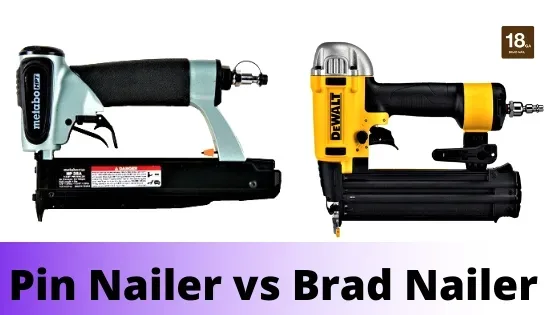

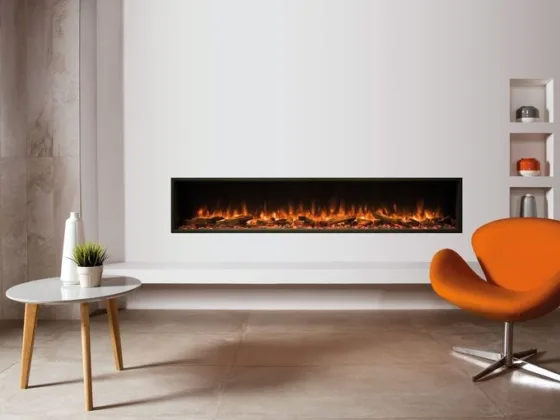








2 comments
Wonderful review article. I have never seen such an article. Very informative and helpful article. Here you have explained the difference Pin Nailer vs Brad Nailer. very informative to all.
Thanks for sharing such an informative article.
Hopefully, waiting for your more article in the future.
Should I buy a brad nailer or a finish nailer?